
The purpose of this article is not to provide ‘A N Other’ opinion about a chef’s output, to be lost in the now ‘me too’ sea of increasing ‘noise’ about top end dining. This is something slightly different, something not seen before, this is an attempt at a new concept. Discerning foodies will recall that at The Michelin Guide GB&I launch event for the 2018 Guides, a slide was briefly discussed by Michael Ellis (WW Director of Michelin Guides), a slide which for the first time highlighted the five criteria followed by inspectors in the awarding of Michelin Stars. Michael Ellis confirmed these under interview on that day, as a reminder these are:-
“The first and most important criteria is the ingredients, all great cuisine starts with great product – the actual product itself is considered for freshness, quality, flavour and texture and so on. The second criteria is mastery of cooking technique – a piece of fish, for example, might have a window as small as 30 seconds where it is perfectly cooked, before that it is undercooked and after that time it is overcooked. Our inspectors are looking for this mastery; albeit something the average diner may not realise but is in actual fact critical to the consistent quality of the experience and a key factor should the restaurant be seeking Michelin star recognition. The third criteria is equilibrium and harmony in flavours; the plate must be in balance, so the sauce is not, for example, overpowering the flavour of the fish or that the seasoning of the dish is found to be exactly as it should be. The fourth criteria is regularity (or consistency) and this means starter, main and dessert are all of the appropriate standard and that each are also consistent over time. Finally, value for money is the fifth criteria.”
So fine dining guide decided that it would be a great idea to sample a Michelin starred restaurant’s output and then interview the chef to discover how they believe their efforts meet those criteria described by Michelin. This would involve the chef analysing each dish prepared, against each of the five criteria.
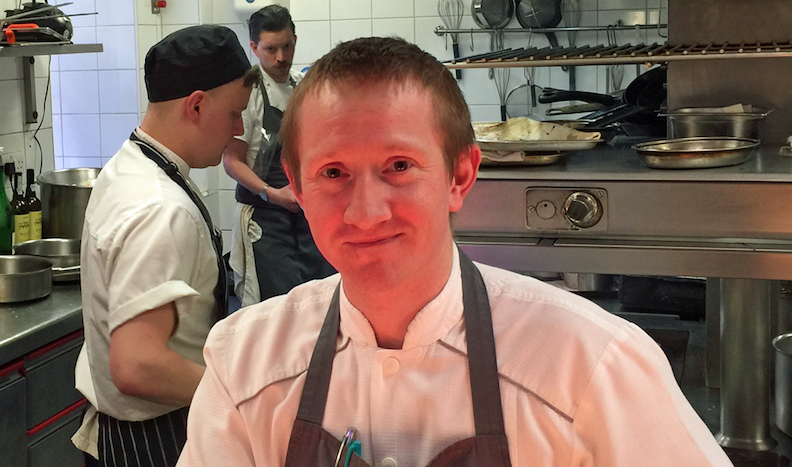
First stop Michelin starred L’Ortolan restaurant, the only such garlanded eaterie in or around Reading. Chef Tom Clarke (above) has some broad influences and inspirations to his cooking; including Asian cuisines, where he particularly appreciates the flavour impacts of certain ingredients which Tom suggests can add great value to strong tasting menus. Naturally, Tom is grounded in the classical style, forged at Le Manoir and further developed under his former mentor Alan Murchison. At interview, Tom appears fairly quiet but very quickly shows his confidence when discussing his home subject, and clearly within burns a desire to succeed shared by all these elite level chefs, indeed one harnessed by a quiet but unmistakable competitive spirit. So to the food but first an overview of a couple of criteria that span the menu – consistency and value for money.
The accent at L’Ortolan is on tasting menus, supplemented by a set menu at lunch time and an a la carte that looks like it has two, two and two choices – in fact there is a separate vegetarian choice on request that effectively brings this up to three, three and three. What I was about to discover over a 40 minute conversation with Tom Clarke was that the level of preparation and multi-stage complexity found in the food, was such that limiting the choice may help ensure consitency of such elaborate dishes. This not to suggest that food is over engineered, far from it, the guiding theme of enhancing flavour results in uncompromising dedication to deliver the processes that meet the optimum flavour punch, admittedly sometimes this is complex, but that is why customers pay for a craftsman’s work, the true wonders of Michelin cooking and the flavours delivered.
L’Ortolan owner Peter Newman has provided Tom Clarke and team with the best of technology to help with recipe, ingredient and cooking process management for the team. There is a L’Orotlan database and a set of iPads for the kitchen to serve as a productivity tool for the chefs while tracking what is happening for the business ensuring the long term efficiency, effectiveness and consistency of the restaurant. Larder, garnish, sauce and pastry are digitally documented, plus each dish that is on the menu along with all methods and recipes. A resulting affect is that in the event of a chef leaving, a stronger foundation is in place to pick up where that chef left off for a new chef on the team. Further, there is clarity of actions required for the kitchen at all times rather than referring to written recipe folders or whatever form of manually written documentation that may happen to have been produced.
In terms of value for money, perhaps the most typical kitchen target is GP on a plate, like any top end restaurant these targets are a moving challenge, why? The costs of ingredients are themselves fluctuating on a regular basis; Tom sites vegetable, fish and dairy costs. For example, over a year, a 10 kilo block of butter was £42 but is now £72 so this forces the kitchen to be creative and find ways to deliver the same or better end product while using less dairy. So, for example, Tom will finish with rendered beef fat for beef or rendered duck fat for duck and not use butter. Wild sea bass is £30 per kilo; langoustines, scallops or turbot and so on are all reaching price points where the restaurant might struggle to source the right quality that would enable combining these ingredients on the same plate. To avoid any compromise on quality in L’Ortolan dishes, the focus is to therefore have the highest quality sourced core ingredient stand out through its individual quality, further enhaced by creative cooking technique.
I have to say none of these honest observations of kitchen cost management were evident in the end products on a plate, which you will see and read below, were quite stunning in conception, deftly skilled in their execution and delivered by a Michelin starred kitchen on full throttle!
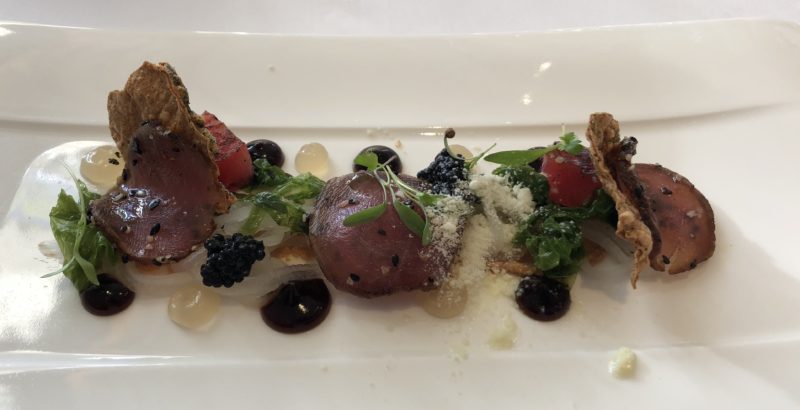
The opening starter dish comprised yellow fin tuna which has proven to be of consistent quality when sourced from different areas via Kingfisher. Tom marinaded the tuna for a couple of hours in a mixture of soya sauce, mirin, kecap manis and wasabi. The tuna was then taken out of the marinade and sealed off quickly before chilling down. The marinade was then reduced down to make a glaze in which the tuna was rolled with sesame seeds. The idea was flavour enhacement upon flavour enhancement. The cracker was for texture, which was a sushi rice cracker made with crab stock to provide an adiditonal but complimentary layer of flavour. Torched water melon for freshness, compressed in sushi ginger giving the sensation of the flavour of having sushi, freshness and acidity of pickled mooli and lemongrass to lift everything and kecap to bring it all together.
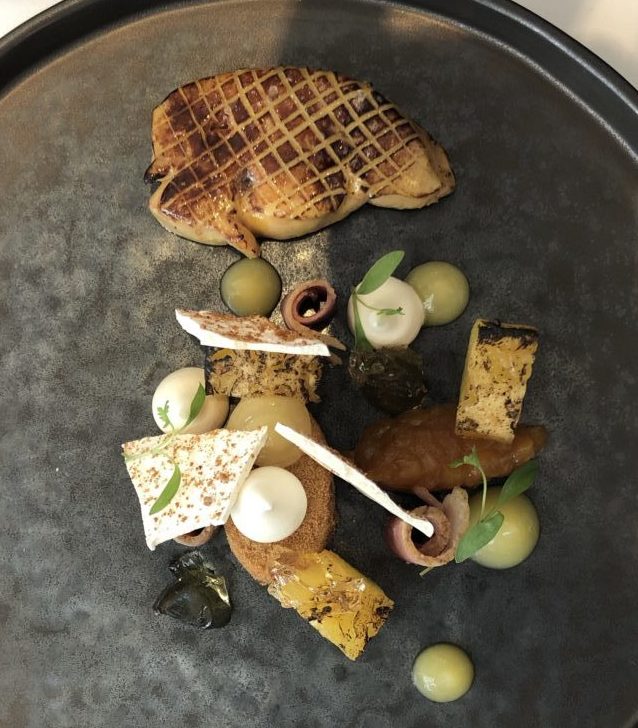
A goose liver parfait rolled in pain d’epices crumb, along side a pan fried goose liver so you have the texture, taste and tempature contrasts of the liver. Pineapple gel, poached pineapple in caramel then torched provides some acidity and sweet wine jelly with a pain d’epice meringue, pineapple meringue, pineapple and coriander chutney and coriander cress. Smoked duck ham add a further dimension of flavour and texture.
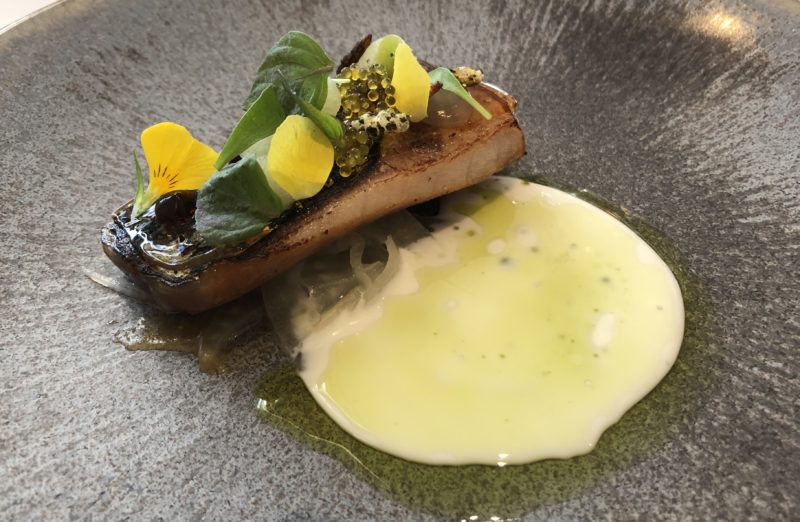
Torched mackerel with Bonito gel and wasabi buttermilk. The Cornish mackerel was marinated along with soya and blowtorched for a smoky flavour and caramalisation. Dried Bonito flakes were used to make a stock which was then made into a gel which covered the mackerel to provide a flavour punch – again the theme is flavour enhacement on top of flavour enhacement and you get both elements in your mouth together. Wasabi buttermilk provided heat and freshness and was created via the process the kitchen developed for making their own in house butter. Some texture is provided by puff rice with seaweed powder for saltiness gives further seasoning.
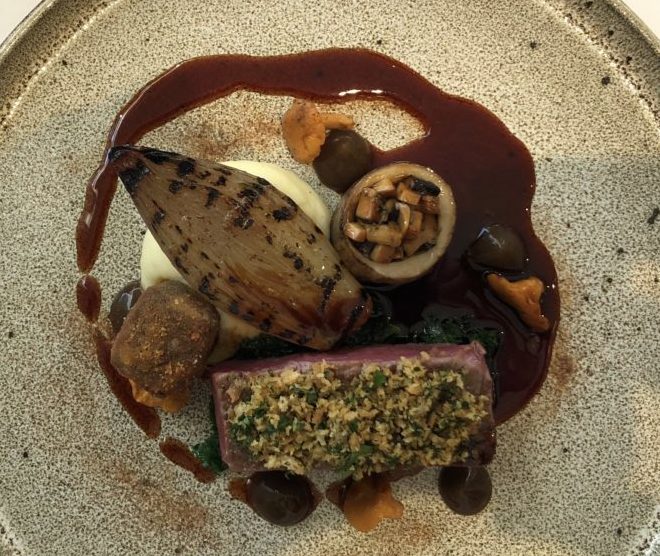
L’Ortolan had a truffle evening a few months ago and from that came this concept for a beef dish. King oyster mushrooms cooked whole and then cooked down in rendered down beef fat with aromats, then broken down to look like a bone marrow. Traditional truffled pomme puree, seasonal carrots, seasonal girolles and confit shallots. Then the blade of beef is marinated in red wine with plenty mirepoix for 24 to 48 hours to tenderize it, make it juicier and more flavoursome. Tom then sealed it to get smokiness into the meat and then waterbathed for 16 to 18 hours. The sauce is reduced red wine and shallots with port and parsley and so on…to really pack in the flavour!

Peanut mousse with a wafer and a feuillantine chocolate base and some gold leaf; coffee and banana work well together with peanut so coffee ice cream sitting on dyhadrated banana and a peanut brittle.
Overall Tom Clarke’s food is well engineered; everything has a purpose to deliver the theme of depth of flavour punch upon depth of flavour. In his maturity the plates are generally getting less technically complex to look at but the skill and craftsmanship in bringing out the true enhanced and deep flavours of his star ingredients goes from strength to strength. For this reason, for me, the beef and mackerel dishes shone through. This is surely a penny dropping. The best food from a great restaurant can look simple but taste sensational, why does it taste sensational? Because countless hours of technical achievements have brought things together in the processes behind the scenes to give the customer the optimum end product experience. This possibly signals to the Michelin aspiring world exactly what they should be aiming for…



